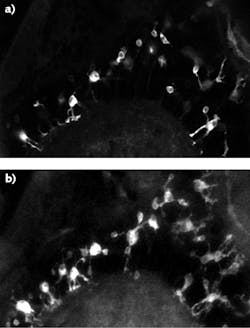Femtosecond fiber laser at 920 nm improves two-photon microscopy imaging

Two-photon microscopy provides deep-tissue imaging in thick/live samples. Optical nonlinearities occur only where high intensity is reached, meaning that—in the case of a focused beam—two-photon excitation takes place exclusively at the focal point where maximum optical intensity is reached. Due to this nonlinear phenomenon, resolution is defined by an excitation volume smaller than the volume covered by the focused beam. And by scanning this tiny excitation spot in three dimensions, a volumetric image is created.
Efficient two-photon excitation requires ultrafast-pulsed lasers capable of producing high peak power with low pulse energy to avoid degradation of living cells. Ti:sapphire lasers produce ultrashort femtosecond pulses at around 800 nm, but higher wavelengths at 920 nm and in the 1030–1120 nm wavelength range are now preferred to reduce scattering and optical damage and to excite fluorescent proteins.
Dispersion compensation
Most two-photon volumetric microscopy applications require watt-level average power with <150 fs pulse duration and repetition rates in the 80 MHz range. Due to dispersion-compensation tailoring, the Alcor 920 femtosecond fiber laser from Spark Lasers (Martillac, France) can produce <100 fs ultrashort pulses with up to 4 W average power at 920 or 1064 nm peak wavelengths with an 80 MHz pulse repetition rate.
Because pulse duration can increase significantly after propagation through complex optical systems due to group-velocity dispersion (GVD), degrading image contrast and reducing depth of field (DOF), the Alcor laser includes a dispersion precompensation scheme. To minimize pulse duration at the sample, the user can control dispersion in a range from 0 to -90,000 fs2 to maximize contrast on the analyzed sample.
Including GVD precompensation, the Alcor laser module has a total length of <25 cm and delivers femtosecond pulses through a single-mode polarization-maintaining optical fiber—critical for live-animal imaging due to its low weight and physical flexibility and robustness.In advanced two-photon microscopy or optogenetics applications, users may have to excite various cells or areas using different pulse energy levels. Relying on a fast acousto-optic modulator (AOM), the Alcor XSight provides >1 MHz bandwidth with active modulation using an analog electrical signal combined with a TTL signal to enable fast pulse gating.
To exemplify the value of GVD compensation, the Alcor 920 laser was used in a two-photon microscopy system developed by Bliq Photonics (Quebec City, QC, Canada) exploiting Bessel beams using axicon technology to increase depth of field at a given acquisition time when imaging green fluorescent protein (GFP)-labeled microglial cells in zebrafish (see figure).
With a combination of high peak power, GVD precompensation, rapid pulse modulation, and fiber delivery, the new lasers outperform Ti:sapphire lasers in two-photon microscopy applications while simultaneously offering a smaller form factor with reduced maintenance and overall lower cost of ownership.
About the Author

Gail Overton
Senior Editor (2004-2020)
Gail has more than 30 years of engineering, marketing, product management, and editorial experience in the photonics and optical communications industry. Before joining the staff at Laser Focus World in 2004, she held many product management and product marketing roles in the fiber-optics industry, most notably at Hughes (El Segundo, CA), GTE Labs (Waltham, MA), Corning (Corning, NY), Photon Kinetics (Beaverton, OR), and Newport Corporation (Irvine, CA). During her marketing career, Gail published articles in WDM Solutions and Sensors magazine and traveled internationally to conduct product and sales training. Gail received her BS degree in physics, with an emphasis in optics, from San Diego State University in San Diego, CA in May 1986.